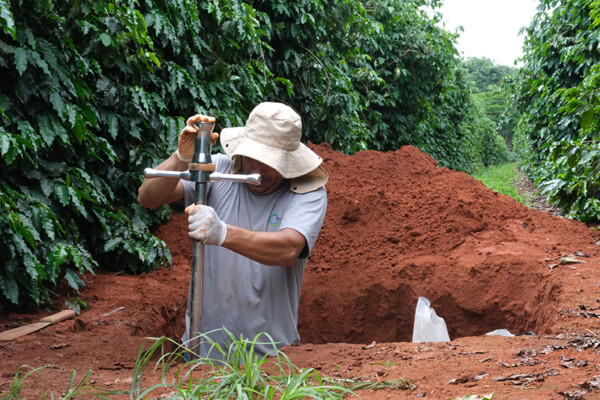Study shows that sustainable coffee plantations sequester more carbon than they emit greenhouse gases into the atmosphere

In view of the growing concern about climate change and the increasingly clear signs for a green global economy, the Brazilian Coffee Exporters Council (Cecafé) developed the Carbon Project, a study conducted under the technical and scientific supervision of the Institute of Forest and Agricultural Management and Certification (Imaflora) and Professor Carlos Eduardo Cerri, from the Luiz de Queiroz College of Agriculture (Esalq), University of São Paulo (USP).
Aimed at estimating the carbon balance in Minas Gerais coffee growing, the project measured the release and sequestration of greenhouse gases (GHG) in the three main regions of Brazil’s leading coffee producer state: South, Cerrado, and Matas de Minas.
The GHG emissions were estimated based on the GHG Protocol and conducted on 40 typical coffee farms in Minas Gerais. In the field stage, soil and coffee tree samples were taken from four pairs of farms representative of regional production realities, in order to quantify the variations in soil carbon stocks up to one meter deep and in plant biomass due to the adoption of conservationist management practices.
“The study findings indicate that adopting good practices in coffee growing generates additional carbon sequestration since even more CO2eq is retained in the soil and in the plant than it is emitted into the atmosphere compared to traditional management, which is already ‘carbon negative’,” explains Professor Cerri.
“Considering the transition from traditional to more conservationist management, the average of the properties assessed showed a negative carbon balance of 10.5 tons of CO2eq per hectare per year, showing that Brazilian coffee production is an important asset for mitigating climate change,” adds Renata Potenza, Imaflora’s Climate and Emissions Coordinator.
This result takes into account the balance between the 12.25 CO2eq/ha/year retained in the soil and plant biomass subtracted from the 1.74 t CO2eq/ha/year emitted through the application of fertilizers and agrochemicals and the use of fuels, electricity, and lime.
TRADITIONAL COFFEE FARMING
Even on the properties where coffee is grown in a more traditional way, the result calculated by the study is positive, since the activity also sequesters more CO2eq than emits GHG, which is explained by the fact that the conventional practices are already more advanced in terms of sustainability.
Based on the results of the study and on data from the specialized literature, a negative carbon balance of 1.63 t CO2eq/ha/year is reached, considering the 3.40 tons sequestered in the plant biomass, against the 1.77 ton coming from the emissions of the production in the field, implying that conventional coffee farming is also “carbon negative”.
Cecafé’s Sustainability manager, Silvia Pizzol, reminds us that, as coffee growing in Brazil is associated with the preservation of native vegetation in rural properties, the study also evaluated the impact of the forest areas maintained by coffee growers: “For each hectare of grown coffee, there is, on average, 50 tons of carbon stored in the form of Legal Reserves and Permanent Preservation Areas (PPA)”, she says.
The conclusion of Cecafé’s Carbon Project studies is scientific proof that Brazilian coffee farming is a fundamental asset to contribute to the reduction of gas emissions associated to climate changes, in that it holds more carbon than it releases into the atmosphere.
“The results are crucial, as they are in line with the greener signs of the world economy and may open doors for Brazil to access the credits directed for activities that respect ESG criteria. Besides, they meet the growing demand of industries and consumers for sustainable products and, finally, they show that the adoption of good practices is vital to mitigate extreme climate effects, mitigating economic impacts on growers’ income,” concludes Cecafé’s general director, Marcos Matos.
In addition to the technical and scientific coordination of Imaflora and Professor Carlos Eduardo Cerri, from Esalq/USP, Cecafé’s Carbon Project has the support of the funding partners Starbucks and Lavazza Foundation, and the implementing partner Educampo, from Sebrae-MG.
* GHG Protocol is the world’s most widely used methodology for quantifying GHG emissions.


Leave A Comment